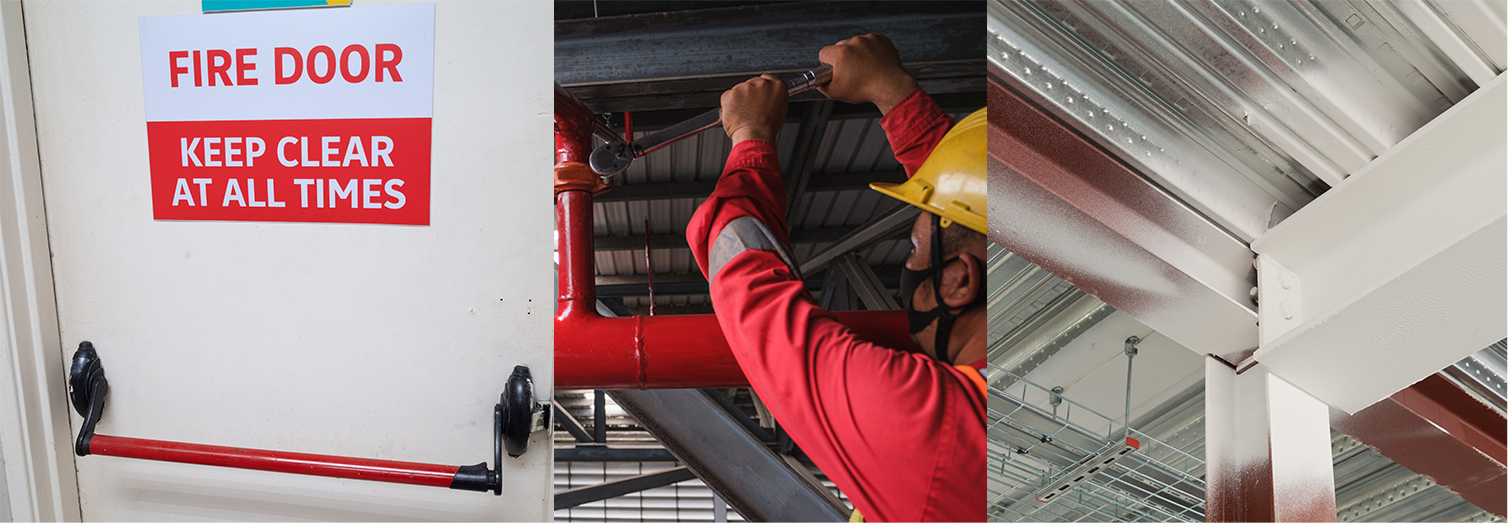PASSIVE FIRE PROTECTION SERVICES

Safety enhances efficiency
Each type of service plays a critical role in the overall fire safety strategy of a building, working together to minimize the impact of fire, protect human life, and reduce property damage. The specific combination and implementation of these services depend on the building’s design, use, and applicable fire safety regulations.
Penetration & Cable Protection
In fire safety, penetration and cable protection are critical components of passive fire protection systems. These are designed to seal openings and protect cables to prevent the spread of fire, smoke, and toxic gases between different sections of a building through gaps created for electrical, plumbing, and mechanical services.
Fire-rated Bulkhead and Access Panels
Fire-rated bulkheads and access panels are essential components in the construction and maintenance of buildings, serving both to protect against the spread of fire and to provide necessary access to building services. These elements are crucial for maintaining the integrity of a building’s fire-resistance capabilities.
Fire Shutters
Fire shutters play a significant role in passive fire protection systems, serving to contain fires and limit the spread of smoke within buildings. They are particularly essential in commercial and industrial settings but are also increasingly used in residential high-rise buildings.
Fire Dampers
Fire dampers are crucial components in the passive fire protection system of a building. Their primary role is to prevent the spread of fire within the ductwork of heating, ventilation, and air conditioning (HVAC) systems.
Intumescent Fire Spray
Intumescent fire spray is a vital component of passive fire protection strategies used extensively in buildings to enhance the fire-resistance ratings of structural members like beams, columns, and ceilings. This type of fire-retardant coating expands when exposed to high temperatures, forming a char that acts as a barrier to insulate the material from the effects of fire.
Vermiculite Fire Spray
Vermiculite fire spray is a type of passive fire protection coating that utilizes vermiculite, a naturally occurring mineral, as a key component. It is primarily used to enhance the fire resistance of structural elements such as steel beams, columns, and concrete surfaces within buildings.

Fire-rated Hebel Wall and Speed panels
Fire-rated Hebel walls and Speed panels are specialized building materials used extensively in the construction industry for their excellent fire resistance properties, as well as for their speed of installation and durability.
Fire-rated Frames and Doors
Fire-rated frames and doors are essential components of a building’s passive fire protection system. They play a critical role in containing fires and preventing the spread of smoke and flames, thereby safeguarding egress routes and protecting life and property.
Passive Fire Audits, Defects Reporting
Passive fire audits are critical assessments aimed at ensuring that all elements of a building’s passive fire protection (PFP) system are correctly installed, maintained, and capable of performing their intended function in the event of a fire. These audits are an essential part of fire safety management, helping to identify potential vulnerabilities in a building’s fire safety strategy and ensuring compliance with fire safety regulations.
AFSS Certification
Anual fire safety statement is a declaration from the building owner that the fire safety measures that apply to a building have been checked and continue to perform to the relevant standard. This helps demonstrate that building owners are maintaining fire safety measures in accordance with section 81 of the Regulation.

Why Zillion Passive Services?
There are many reasons for your business to trust Zillion Passive Services. Our years of hands-on experience in the industry has enabled us to create a work culture which truly values clients’ resources and provides complete value for their money.
- Experienced Team Zillion Passive Services boasts a team of highly skilled professionals and associates with extensive experience in fire protection.
- Compliance Assurance We ensure that all services comply with relevant fire safety regulations and standards, providing clients with peace of mind and legal compliance.
- Customized Solutions Zillion Passive Services understands that each business has unique fire safety requirements, and offers tailored solutions to address specific needs and challenges.
- Proactive Maintenance Zillion Passive Services emphasizes proactive maintenance and regular inspections to detect and address potential issues before they escalate into emergencies


Why is Passive Fire Protection important?
Passive fire protection is essential for safeguarding both lives and property in commercial buildings, ensuring compliance with regulations, reducing financial risks, and maintaining business continuity.
The primary reason for implementing passive fire protection measures is to protect the lives of the building occupants. It helps contain fires within a limited area, preventing or delaying their spread throughout the building. By containing fires to the area of origin, passive fire protection also helps in minimizing property damage This can significantly reduce the financial losses associated with fire incidents, including damage to buildings, equipment, inventory, and other assets.
Fire incidents can disrupt business operations, leading to downtime, loss of revenue, and damage to the reputation of the business. Passive fire protection measures can help mitigate these risks by minimizing the impact of fires and allowing for faster recovery and continuity of business operations.
Many building codes and regulations mandate the implementation of passive fire protection measures to ensure the safety of occupants and protect property. Compliance with these codes is essential for obtaining permits, insurance coverage, and maintaining a safe working environment.

Important Information
FREQUENTLY ASKED QUESTIONS
Why is fire protection crucial for commercial buildings?
Fire protection is vital for safeguarding lives, minimizing property damage, ensuring business continuity, and maintaining compliance with safety regulations. It helps manage risks associated with fire, which can be catastrophic in densely populated or high-value property areas.
What are the components of a good fire protection system?
A comprehensive fire protection system includes fire detection systems (like smoke alarms), fire suppression systems (such as sprinklers and fire extinguishers), proper signage (exit signs and evacuation maps), and regular maintenance and inspection protocols to ensure everything functions correctly.
WHAT THEY ARE SAYING
ABOUT COMPANY
Zillion Services was outstanding in upgrading our fire safety protocols. Their attention to detail and expert guidance were invaluable. We feel much safer thanks to their professionalism.
Robert Dickson - Director
Statewide fire Pty Ltd






